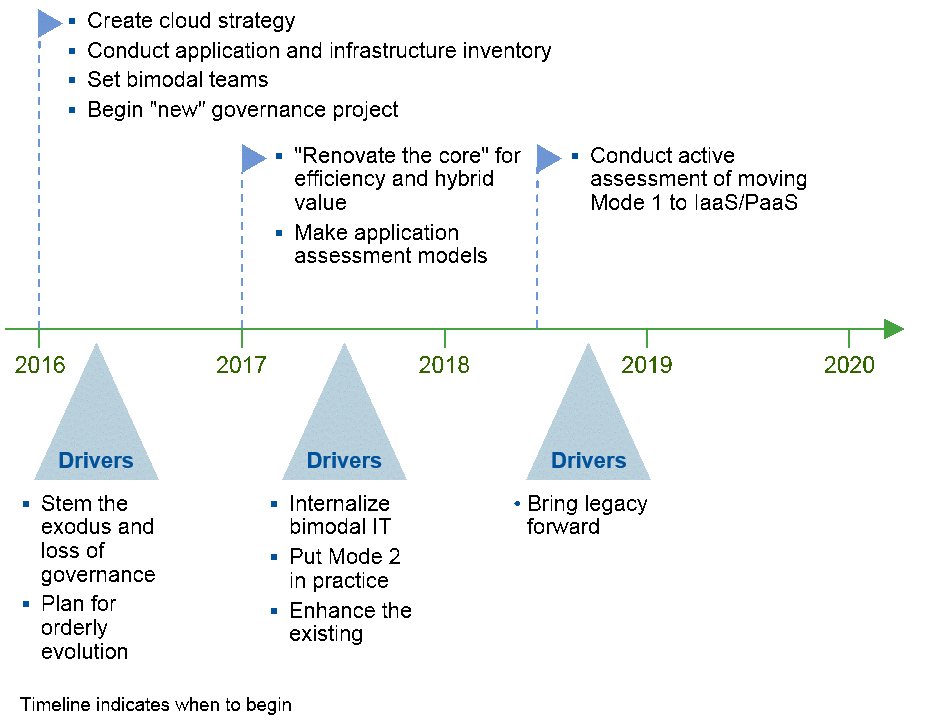Bimodal Approach to IT Meets Digital Business Challenges – Coordinating Services, Not Controlling Assets

Businesses embracing agility and scalability as part of digitalization onboarding will have to adhere to hybrid compute and storage models based on multiple infrastructure as a service (IaaS) and platform as a service (PaaS) providers, according to Gartner's Strategic Roadmap for Datacenter Infrastructure report that can be downloaded here. With 10 percent of organizations closing off their on-premise data centers by the end of 2018, 80 percent of enterprises will adhere to IaaS and PaaS by 2019.
Some of the fundamental trends that will help businesses grow faster and focus more on services and less on assets involve the adoption of a bimodal (Mode 1 and Mode 2) approach to IT built around reliability and agility. Both Mode 1 and Mode 2 require unique skills, processes and tools, while at the same time adopting IaaS for completely different use cases.
However, the strategic roadmap for use of cloud infrastructures will likely depend on the individual needs of each company, as well as their long-term plans for transformation. While some businesses might opt for greenfield infrastructures where everything’s built from the ground up and physical infrastructures don’t exist, others might choose a slower, less disruptive approach, where existing on-premise infrastructures and cloud-based assets are cohesively merged.
“Business units looking for greater capabilities in shorter periods of time are bypassing IT in accelerating numbers, as a flood of external options for application services unheard of just five years ago have arrived in conjunction with cloud computing,” reads the Gartner report. “To better address fast-moving, ever-evolving business demands, the IT organization must become leaner, faster and more agile, and take on the critical role of coordinating services, not controlling assets.”
The current state of data centers still revolves around on-premise applications and data, while business units are constantly circumventing IT in search of more agile cloud services. However, private clouds will not be able to keep up with the agility provided by hyperscale public Iaas and PaaS, and it’s estimated that data centers will become a mesh of premises-based, colocated, hosted and cloud-provided services.
Gartner estimates that the bimodal approach to IT will provide the organizational and process framework organizations need to migrate towards hybrid infrastructures, as most organizations plan to dispose of their on-premise data centers on the long run.

“Creating such a long-term strategy, roadmap and evolution plan allows enterprises to view IT solutions to business demands as a constantly improving dance,” according to Gartner. “The migration and evolution plan […] is broken into short-term, medium-term, and long-term projects. These are not necessarily different from the perspective of priority, just the time in which we expect them to be relevant.”
While the need for on-premise data centers infrastructures is unlikely to completely go away, Gartner believes that businesses should embrace strategy and not technology when driving the overall infrastructure strategy. Recommending both mid-term and long-term strategic planning for their data centers, enterprises are encouraged to build their strategy around delivering services that meet enterprise requirements.
tags
Author

Liviu Arsene is a Global Cybersecurity Researcher for Bitdefender, with a strong background in security and technology. Researching global trends and developments in cybersecurity, he focuses on advanced persistent threats and security incidents while assessing their impact in critical public and private business infrastructures. His passions revolve around innovative technologies and gadgets, focusing on their security applications and long-term strategic impact.
View all postsRight now Top posts
FOLLOW US ON SOCIAL MEDIA
SUBSCRIBE TO OUR NEWSLETTER
Don’t miss out on exclusive content and exciting announcements!
You might also like
Bookmarks










